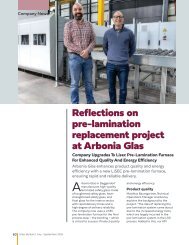Edition 57 (Jan-Mar, 2020)
Create successful ePaper yourself
Turn your PDF publications into a flip-book with our unique Google optimized e-Paper software.
Glass Terminology
Most Cintra glass was made by picking
up chips of colored glass on the parison
and then casing them with a thin layer
of (usually) colorless glass.
Glass Terminology
Acid Stamping: The process of acid
etching a trademark or signature
into glass after it has been annealed,
using a device that resembles a rubber
stamp.
Alabastron: (Greek) or Alabastrum
(Latin): A small bottle or flask for
perfume or toilet oil, usually with
a flattened rim, a narrow neck, a
cylindrical body, and two small handles.
Ale Glass: A type of English drinking
glass for ale or beer. Ale glasses, first
made in the 17th century, have a tall
and conical cup, a stem, and a foot.
They may be enameled, engraved, or
gilded with representations of hops or
barley.
Apse: The semi-circular termination of
the east end of the chancel or chapel.
At-the-Fire: The process of reheating
a blown glass object at the glory hole
during manufacture, to permit further
inflation and/or manipulation with
tools.
Baptistery: A separate room or
building of a church containing the
font.
Bar (Barring): A single piece of glass
formed by fusing several canes or rods.
A bar can be cut into numerous slices,
all with the same design, to be used
as inlays or appliqués, or in making
mosaic glass.
Bevel: Cut and polished edge usually
on plate glass at an angle other than
90°, done in stages with roughing,
smoothing, cork and felt wheel
polishing.
Blasting: Shorten term used for sand
blasting, a technique of etching and
carving glass using an abrasive under
pressure.
Blobbing: The technique of decorating
hot glass by dropping onto the surface
blobs of molten glass, usually of a
different color or colors.
Carnival Glass: Inexpensive pressed
glass with vivid gold, orange, and
purple iridescence, made in the United
States between about 1895 and 1924.
It is so called because it was frequently
offered as fairground prizes.
Cartoon: The name for the working
drawing for a stained glass design
which contains all the cutlines. It
can also contain paint lines, color,
grain directions, piece numbering, an
other information. It is essentially the
blueprint for the work.
Carving: The removal of glass from the
surface of an object by means of handheld
tools.
Casement Window: A window sash
hung by hinges and fastened to the
window frame.
Chunk Glass: Another name for Dallede-Verre
and slab glass. Generally they
are glasses 8” x 12” and 1” thick.
Cintra Glass: A type of decorative
glass developed by Frederick Carder
(1863-1963) at Steuben Glass Works
in Corning, New York, before 1917.
Diatreta: A term used by Frederick
Carder (1863-1963) to describe
openwork objects, which he made by
lost wax casting.
Dichroic Glass: Made by vacuum
depositing a special coating onto a glass
sheet. The process creates a mirror like
finish that reflects a specific color but
when the glass is held up to the light,
a different color is seen (transmitted)
through the glass.
Dip Mold: A cylindrical, one-piece
mold that is open at the top so that the
gather can be dipped into it and then
inflated. See also Optic mold.
Fan Lamp: A style of flat lamp whose
general shape resembles a ladies
fan that is then held upright in base
with a socket behind it to provide
illumination.
Favrile: Iridescent glass patented by
Louis Comfort Tiffany in the 1880s,
produced by the exposure of hot glass
to metallic fumes and oxides.
Fiber Blanket: A refractory, flexible
sheet used to control the cooling rate
of hot glass items.
Fiberboard: Pressed ceramic fiber
material used to create drop molds or
walls for casting frit
Gilding: The process of decorating
glass by the use of gold leaf, gold
paint, or gold dust. The gilding may be
applied with size, or amalgamated with
mercury. It is then usually fixed to the
glass by heat. Gold leaf may be picked
up on a gather of hot glass.
Goethe Glass: A clear blown glass
without seeds or striation, just a slight
surface distortion from the blowing
process, similar to old window glass.
Email: support@glassbulletin.com
Website: www.glassbulletin.com
Glass Bulletin | January - March, 2020 95


















